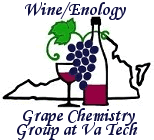 Enology Notes #33 November 9, 2001
Enology Notes #33 November 9, 2001
To: Regional Vintners and Prospective Vintners
From: Bruce Zoecklein
Subject: Controlled Aeration of Reds, Mouth-feel Wheel, Laboratory Service Reminder
Controlled Aeration of Red Wines. In addition to the management of phenols in the fermenter, winemakers must continue that management throughout the life of the wine. This is particularly important during the first year post-fermentation. Controlled aeration of reds is a production tool to enhance color stability, evolve and soften tannins, and help lightly structured wines by providing body.
Red wine color results from the integration of monomeric phenols (including anthocyanins) into polymeric structures. During fermentation and storage, condensation reactions occur, producing polymeric structures. Our delestage research has demonstrated large differences between the pigments in the fruit vs. wine , with the greatest difference occurring in the amount of large polymeric pigments. Only a small percentage of the pigments are in the polymeric form in the fruit (8-15%). Fermentation and post-fermentation aeration increase this percentage substantially.
Tannins stabilize anthocyanins by binding to form larger polymeric pigments. At the same time, tannins become more supple. Post-fermentation controlled aeration increases the rate of reaction of coloring matter with tannins, resulting in condensation, polymerization and enhanced suppleness.
Aeration judgments are based on style, phenol content and pH, with air exposure accomplished by aeration during tank racking, barrel to barrel racking and, of course micro-oxidation (see Vol 15. No 2 of the Vintner's Corner at www.fst.vt.edu/zoecklein/index.html. An update on our micro-oxidation research will be provided in subsequent editions). Too much air exposure too late in the development of a wine can cause precipitation of the tannin-anthocyanin complex and oxidation.
Acetaldehyde is produced as a result of the oxidation of ethanol, which can occur quickly as a result of splash racking or slowly due to barrel aging. This aldehyde formation provides the chemical bridge to bind anthocyanins and tannins together. The rate of oxidation is a function of temperature, pH, sulfur dioxide and content of oxygen buffers (certain types of phenols, products from sur lie storage, etc.). During the development of red wines, it is possible to modify the formation of the anthocyanin-tannin complex (and, therefore, color stability and palate structure) by adjusting the quantity of dissolved oxygen, sulfur dioxide or both. The higher the pH, the greater the rate and extent of oxidation. This may be an important consideration this year.
Sulfur dioxide slows or inhibits the formation of the tannin-anthocyanin complex by binding acetaldehyde, tying up the bridge needed in the formation of the complex. Thus, free SO2 should be kept below 15 mg/L in young red wines if the goal is to stabilize color and evolve tannins. The lower the free sulfur dioxide, the faster the rate of complex formation. This requires the use of an accurate method of SO2 determination . This means the use of the Aeration Oxidation (AO) procedure (see Vintner's Corner Vol. 13 No 5 at www.fst.vt.edu/zoecklein/index.html).
In practical terms, the questions are 1) how much oxygen is needed for optimal maturation without provoking phenolic instability or excessive oxidation? and 2) how late in wine maturation can controlled aeration occur? The answers to both questions relate to the level of total phenolics present and style. However, the younger the wine, the greater is the percentage of phenols in the monomeric, non-polymerized form. Aeration is most effective immediately following fermentation when the tannins are only slightly polymerized. At this stage, the condensation of tannins with anthocyanins, in the presence of air, will help stabilize pigments.
High tannin wines are often provided with air exposure 3-4 times in the first year. Depending upon the phenol load and desired style, wines are usually stored anaerobically during year 2 and beyond. Naturally, the use of controlled aeration must be appropriate to the structure and pH of the wine. In light red wines, which are low in phenolic compounds, exposure to air is generally limited. This is generally the case with Pinot Noir. In order to limit air exposure, low phenol varieties are sometimes barrelled and left sur lie to provide the wine with some autolysis products to help buffer the effects of oxygen and add palate weight.
Mouth-feel Wheel. As a means of helping to define the palate structure of wines, Gawel et al. (2000) developed a mouth-feel wheel. I presented and discussed this at the Norton Roundtable meeting in July. If you desire a copy, write my office.
Laboratory Service Reminder. The Enology-Grape Chemistry Laboratory conducts supplemental, quality control analyses for the Virginia wine industry. This service is designed to support, not replace, in-house analyses. We provide protein, bitartrate and microbial stability analysis and trouble-shooting. HPLC analysis for organic acids (used mainly for monitoring MLF status) is conducted by the Enology-Grape Chemistry Lab on the first and third Wednesday of each month.
Subscription to Enology Notes. All past Enology Notes and Vintner's Corner newsjournals are posted on the Enology-Grape Chemistry Group's web site at: www.fst.vt.edu/zoecklein/index.html. Enology Notes are different in content from this subscription-based Vintner's Corner newsjoural. To be added to the Enology Notes list serve send an email message to bzoeckle@vt.edu with the word ADD in the subject line.
Dr. Bruce Zoecklein
Associate Professor and Enology Specialist
Head, Enology-Grape Chemistry Group
Department of Food Science and Technology
Virginia Tech, Blacksburg VA 24061
Enology-Grape Chemistry Group Web address: www.fst.vt.edu/zoecklein/index.html
Phone: (540) 231-5325
Fax: (540) 231-9293
E-mail: bzoeckle@vt.edu